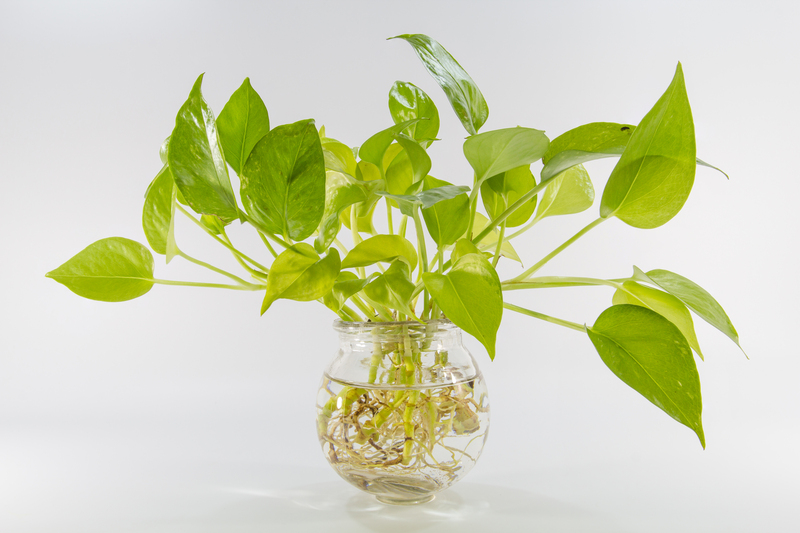Nature's Cycle: Waste to Flourishing Soil
Posted on 07/06/2025
Nature's Cycle: From Waste to Flourishing Soil
Every day, we generate waste, especially organic matter that often ends up in landfills. But what if this waste could revive our soils, boost plant growth, and close nature's essential loop? The journey from waste to flourishing soil is both a natural miracle and a practical process anyone can be part of. In this comprehensive guide, we'll explore the magic behind transforming waste into fertile earth, highlighting methods, benefits, and ways you can join in this vital ecological cycle.
Understanding Nature's Cycle Organic Waste: The Starting Point Composting: Nature's Engine for Soil Fertility Vermicomposting: Harnessing Worm Power The Role of Microbes: Unseen Heroes of Soil Health How Flourishing Soil Benefits Ecosystems Home and Community Composting Tips Innovative and Large-Scale Initiatives Challenges and Solutions Your Role in the Waste to Soil Movement
Understanding Nature's Cycle
At the heart of every thriving ecosystem lies a powerful cycle: the transformation of waste materials into life-sustaining soil. This process, often called nature's cycle of waste to soil, mimics what happens on a forest floor, where leaves, branches, and animal droppings decompose and replenish the earth.
Through decomposition, organic material gets broken down by fungi, bacteria, insects, and other decomposers, ultimately forming rich, organic soil that supports new plant life. This closed-loop process ensures that nutrients are recycled, maintaining soil fertility and promoting continuous plant growth.
Why is Nature's Soil Cycle Important?
- Reduces landfill waste and environmental pollution
- Returns vital nutrients to the earth for healthy plant growth
- Supports biodiversity by enriching soil for various microorganisms and plants
- Improves soil structure and water retention, protecting against erosion and drought

Organic Waste: The Starting Point
All journeys begin somewhere, and in the cycle of transforming waste into flourishing soil, it starts with our organic wastes. Common sources include:
- Fruit and vegetable peelings
- Coffee grounds
- Eggshells
- Yard clippings and leaves
- Cardboard and paper (uncoated)
- Animal manure (from herbivores)
It's vital to note that not all waste belongs in compost--meat, dairy, and oily foods can lead to pests and odors and should be avoided in typical compost piles.
Composting: Nature's Engine for Soil Fertility
Composting is the intentional process of converting organic matter back into usable, nutrient-rich soil. By managing the decomposition process, we can speed up nature's soil-building cycle and produce what is known as black gold for gardeners and farmers.
The Science Behind Composting
Composting is driven by a balance of "greens" (nitrogen-rich items) and "browns" (carbon-rich materials). Microorganisms play a critical role by breaking down these materials in the presence of air and moisture, generating heat and eventually creating humus, the organic heart of fertile soil.
- Greens: Vegetable scraps, grass clippings, coffee grounds
- Browns: Fallen leaves, straw, shredded paper, wood chips
Benefits of Composting
- Reduces green waste sent to landfills
- Produces natural fertilizer for gardens, lawns, or farms
- Enriches soil with nutrients and beneficial microbes
- Decreases the need for chemical fertilizers, making agriculture more sustainable
- Cuts methane emissions from landfills, a potent greenhouse gas
Vermicomposting: Harnessing Worm Power
For those who want to accelerate the cycle from waste to fertile soil at home or in small spaces, vermicomposting--using earthworms--offers a simple solution. Red wiggler worms are the stars, consuming food scraps and leaving behind nutrient- and microbe-rich castings.
How to Start Vermicomposting
- Get a Worm Bin: Use a ventilated container to house worms and bedding.
- Feed Regularly: Add fruit and vegetable waste, coffee grounds, and eggshells.
- Avoid: Citrus, onion, meat, and dairy, which can upset worm health.
- Harvest Castings: In a few months, collect the crumbly castings--amazing for gardens and potted plants!
Vermicomposting is a tangible way anyone can support nature's waste-to-soil cycle--even in small urban apartments!
The Role of Microbes: Unseen Heroes of Soil Health
When we think about transforming waste into flourishing soil, we often picture worms or decomposing leaves. Yet, the true hidden workers are the billions of microbes in every handful of healthy soil. These bacteria, fungi, and actinomycetes:
- Break down complex waste into simpler nutrients
- Convert nitrogen and other elements into plant-available forms
- Create antibiotics, suppressing plant diseases naturally
- Build soil structure through organic matter
Supporting the microbial life in your soil ensures long-term fertility and the continuation of nature's waste-to-soil conversion process.
How Flourishing Soil Benefits Ecosystems
Transforming waste into organic-rich soils doesn't just help your garden or farm--it benefits entire ecosystems. Here's how:
- Enhanced Water Retention: Healthy, compost-rich soil absorbs and holds more water, reducing floods and helping plants survive droughts.
- Carbon Capture: Composting and soil improvement store carbon in the ground, mitigating climate change.
- Biodiversity Boon: Rich soil supports native plants, pollinators, birds, and beneficial insects.
- Food Security: Nutrient-dense soil leads to better harvests and healthier food.
Flourishing soil is the bedrock of resilient, self-sustaining ecosystems--both natural and cultivated.
Home and Community Composting Tips
Whether you have a large garden or a tiny balcony, you can participate in the cycle that turns waste into prosperity. Here are practical steps to get started:
- Pick Your Method: Choose between traditional outdoor piles, bins, tumblers, or indoor worm composters.
- Balance Greens and Browns: Maintain a rough ratio of three parts carbon-rich "browns" to one part nitrogen "greens."
- Keep It Moist: Like a wrung-out sponge, compost should be damp but not soggy.
- Turn or Stir Regularly: This adds oxygen, speeding up the breakdown process.
- Harvest Your Compost: Finished compost is dark, crumbly, and smells sweet--like forest soil.
Tip: Use your compost in vegetable beds, flower gardens, even for houseplants. It's the most natural soil amendment available!
Community Composting
If you lack space, look for community compost drop-offs, farmer's markets, or local garden programs. Some cities now offer municipal compost pickup, helping turn neighborhood waste into flourishing, fertile community gardens.
Innovative and Large-Scale Initiatives
Across the world, innovators are scaling up nature's cycle with creative, sustainable projects, including:
- Industrial Composting Facilities: Processing tons of food scraps and yard waste from cities to produce compost for farms and landscaping.
- Farmer-Led Soil Health Programs: Teaching sustainable practices and closing nutrient loops regionally.
- Eco-Agri Startups: Developing smart composting solutions and soil-enhancing products from restaurant and grocery waste.
- Circular Economy Programs: Integrating waste recovery with local agriculture, creating jobs and reducing emissions.
These innovations demonstrate the power of waste-to-soil transformation at every scale -- nourishing crops, reducing landfill dependency, and building healthier communities.
Challenges and Solutions in the Waste-to-Soil Process
The cycle of nature from waste to flourishing soil faces real-world obstacles:
- Contamination: Plastics, chemicals, and non-biodegradable materials disrupt compost cycles.
- Pest Problems: Poorly managed piles can attract rodents or insects.
- Odors: Overly wet or anaerobic piles may smell unpleasant.
- Urban Barriers: Lack of space or support for composting in cities.
Solutions include:
- Proper Waste Sorting: Educate and encourage residents to separate compostable from non-compostable waste.
- Secure, Bin-Based Systems: Enclose compost in bins with tight lids in urban or small garden environments.
- Regular Maintenance: Aerate piles, monitor moisture, and harvest compost promptly.
- Community Education: Workshops, signage, and incentives make composting more accessible and effective.
Solving these challenges is crucial to keeping nature's cycle alive and flourishing across all spaces--from home gardens to city landscapes.

Your Role in the Waste-to-Flourishing Soil Movement
Every individual's effort matters in nature's ongoing cycle of waste to life-giving soil. By composting at home, supporting local initiatives, and spreading awareness, we become partners in an ancient, essential process.
- Start a compost bin or worm tower--even on a balcony or backyard.
- Shop local farmers using regenerative soil practices.
- Advocate for municipal composting programs.
- Educate neighbors and children about why healthy soil matters.
- Harvest and use your compost--grow a little, give a little to friends or community gardens!
By joining this movement, you help complete nature's cycle--from waste to thriving, nourishing soil, ensuring the next generation inherits a healthier, greener planet.
Conclusion: The Power of Closing the Natural Loop
Nature's cycle of waste to flourishing soil is both ancient and urgently modern. It is a testament to the resilience and wisdom of ecological systems. By mimicking and supporting this process through composting and mindful waste management, each of us holds the power to heal the earth, enrich gardens, and support life's abundance.
So the next time you peel a carrot or rake autumn leaves, remember: you're holding the beginnings of tomorrow's fertile ground. Let's close the loop, nurture our soils, and grow a flourishing future--one handful of compost at a time.

